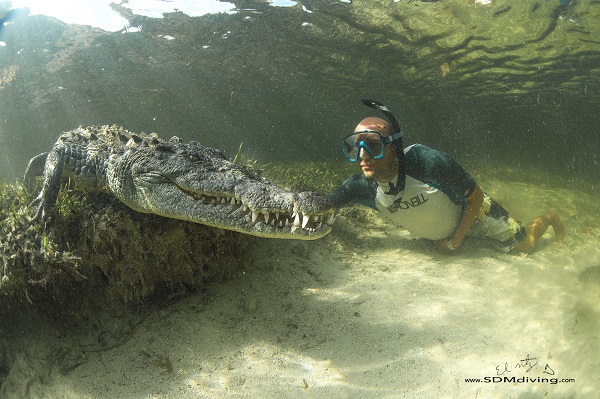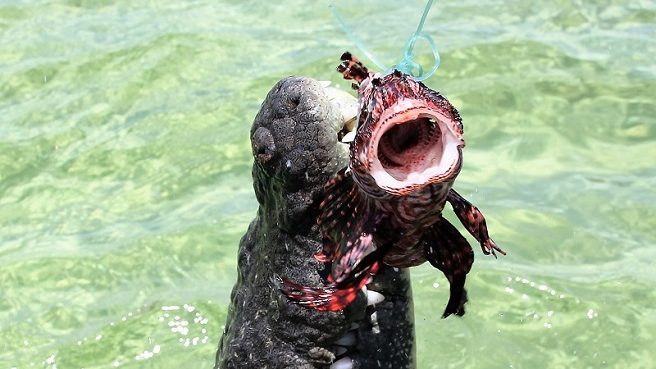Rock the Croc! Part 4 continues after a great first day of diving with crocodiles Mexico.
The second day is breaking. Again, we set off for a dive to catch lionfish, and on this day, we are lucky and a little disappointed. Lucky in that the reef is beautiful and we discover numerous shoals of fish and moray eels. And a little disappointed that practically under every rock we find the invasive lionfish.
We cannot keep up with the harpooning. Mark powers up so much that his air supply is already used up after 30 minutes and he has to surface. I, too, get caught up in the hunt. When I look at the depth gauge, it indicates 42 meters (137 ft)! Pretty deep, I’ve never been so deep. I look up and see Ernesto signaling me to come up to 20 meters (65 ft). When we get back on the boat, we count 19 lionfish, a good yield.
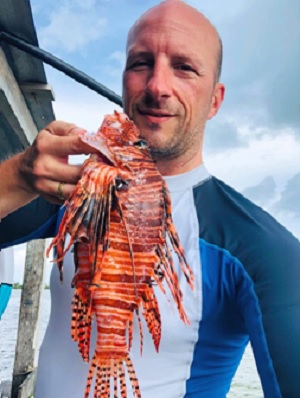
After our return, the crew starts with the same routine: Splashing with the bucket in the water, throwing fish on a leash. But somehow, no crocodile can be seen. Slowly, it dawns on us: We gave them too many fish to feed on the first day; they are full and resting in the mangroves.
One of the men from the XTC diving center, who accompanied us, jumps into the water, goes into the seagrass and hits the water with a long stick for several minutes. Even the crocodiles in Cancun would have to hear that noise! Despondency or lack of commitment cannot be blamed on the crew members. But, without success, no crocodile shows up.
When it’s midday, Eli suggests visiting the ranger station on the island, which is about two kilometers (1.2m) away. Once there, we are warmly welcomed and guided around. Everywhere we see big Green Iguanas, about .91 to 1.2 meters (3 to 4 feet) long. With their long tails and the orange spines on their backs, they really look like a miniature Godzilla. If they were as big as the crocodiles, you could get scared. But luckily, they are harmless herbivores.
Greg wants to take a nice photo and moves closer—and deeper into the bush. Suddenly, I see a crocodile is only two meters (6 ft) away!
“Watch out Greg, croc to your right,” I warn him. He is scared when he sees the crocodile. Just like dead, it lies there and does not move. A little farther is one more . . . and another one.
Once again, I am fascinated by the animals’ excellent camouflage. No wonder a careless child or woman who wants to wash clothes by the water can be the victim of an attack. Can you then blame the crocodile? It’s a similar situation as if we are staring into our cell phone and crossing the street on a red traffic light. Who is to blame when it comes to an accident?
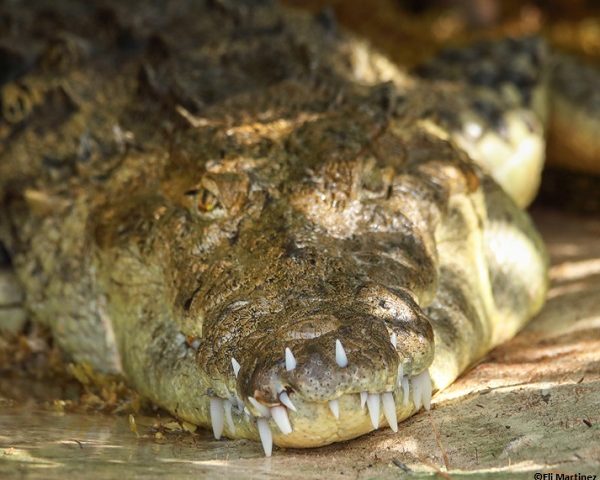
One of the crocodiles looks pretty scary because the teeth of his lower jaw have drilled through his upper jaw. It is not uncommon, as Eli explains. But the animals do not mind that. Some big and old crocodiles have no teeth at all—but still they can hunt and kill, because the pressure of their jaws crushes everything! Crocodiles have the strongest biting power in the entire animal kingdom.
Back at our stilt house, we try again to attract the animals. And now three new crocodiles appear. But they are shier, they come to us only for a short time and disappear quickly. The four other guys are lucky and get water time again, but Alex and I go away empty-handed.
No worries, because we manage to take great photos from the jetty. The darkness doesn’t come slowly, as it does in European latitudes, it’s suddenly there. Most men go to sleep, but Mark, Garin, Greg, and I do not have enough yet. We grab the leash with the lionfish and throw it out. It is pitch black, but luckily Garin and Greg have brought two powerful flashlights.
Point by point, we light up the water surface. The bait floats like a water lily on the surface and suddenly–wham, a crocodile appears out of nowhere and has caught the fish. Now the tug-of-war begins. The animal could easily bite off the fish or bite the line, but it does not. Maybe it suspects a hook on the matter? In any case, we play tug-of-war with the animal for an hour, back and forth.
If it’s already been a daytime thrill to see crocodiles so close, it’s an immeasurable increase at night. We holler and jump around like crazy, a miracle that the others do not wake up. Shortly before midnight, we leave the crocodile its well-deserved prey and happily lie down in the hammocks.
The third and last day with the crocodiles starts. This time, we do not dive to harpoon lionfish, as we still have enough bait from the day before. The morning starts like the second day. For an hour we try to lure the crocs by all means, but none can be seen. Damn, I would like to join them in the water again! The trip has already exceeded my expectations, but still.
Once you have been so close to the animals, you cannot get enough. And then, they suddenly show up: First Gambit, then Cut Tail and two new animals. Eli already knows them, it’s Bobo and Pinto. Pinto has a white discoloration on the back, so he is easy to recognize. All four animals come close to us at the jetty. Alex and I start again and go into the water, supervised by Ernesto.
None of the crocodiles are farther than 9 meters (30 ft) away from us, they have virtually surrounded us. A mix of fear and fascination is spreading around us, but we are too focused to really get scared. The other guys also pay attention from their elevated position of the stilt house, so that no crocodile sneaks up from behind and surprises us.
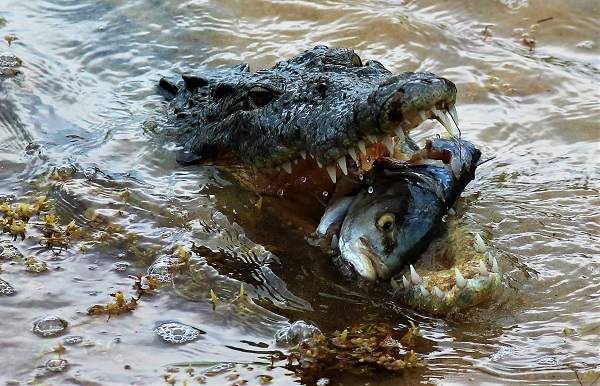
Pinto especially keeps us on our toes; he does not seem to know the mangrove etiquette and swims all over the place. He also does not care about Gambit, who is at least 60 centimeters (2 ft) bigger. Pinto is the animal that we REALLY have to keep an eye on. If an animal would dare to attack, it’s Pinto!
This time I’m not so sad when the 30 minutes water time is over and I climb back onto the jetty. Even with Greg and Johnny, the situation remains tense and as Mark and Garin dive into the water. Three more crocodiles appear on the scene. Now they are dealing with seven animals in the immediate vicinity! And one of the crocs takes our breath away: it is even bigger than Gambit, and is a good 3.7 meters (12 ft) long.
Greg gives him the name Godzilla. The name is very appropriate, because with his wild, prehistoric appearance, he makes the movie monster look like a Gecko. But, fortunately, like Gambit, he is very sociable. To estimate his size even better, Eli dives to the ground and lies down, next to Godzilla in the sand. The reptile does not even flinch, even with Eli just 1.5 meters (5.5 ft) away, making the croc look even more gigantic. The animal is more than twice as long as the Texan.
Then it’s Alex and my turn again. Do I really want to jump into the water with seven big crocodiles? Sure, of course!
Our cameras are filming and we shoot photos without taking our finger off the shutter button. Afterward, I find out that I took more than 1,000 shots in the three days, but the end has not come yet. Godzilla and Gambit take turns snapping at the fish, but since the man handling the bait line is focused, they miss it. When their jaws snap, the air escapes from their mouth in fractions of a second and it sounds like the bonnet (hood) of a pick-up truck is slamming down!
The third day tops everything that has happened before, but after six hours we have to leave camp and drive back to Xcalak. After all, we do not want to dare the crossing in the dark; I cannot think I would want to experience that.
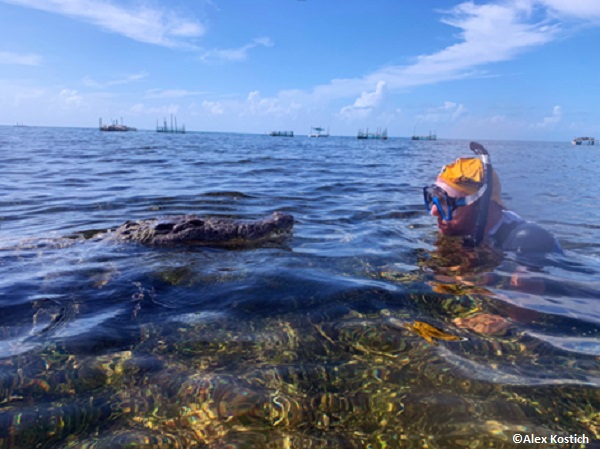
Altogether we have seen 18 different, wild American crocodiles. It’s crazy. Before the expedition, it would have been enough for me to swim with just one crocodile, so now I cannot get that big grin off my face. Thanks, Eli!
This concludes Rock the Croc! Diving with Crocodiles.
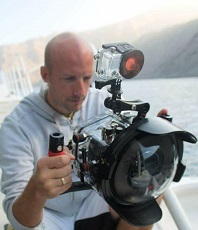
Christian Kemper is a TV journalist from Germany and freelance writer for three of the biggest diving magazines in Germany. He has been diving with and studying sharks for more than 20 years. The author has written two books about shark attacks and is about to publish his first English language book about sharks titled “The Fear Beneath.”
You can find his German Language book “Strange Pool Friends” on Amazon and at tredition.
He has also written several articles about sharks.

